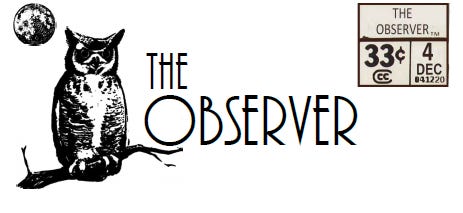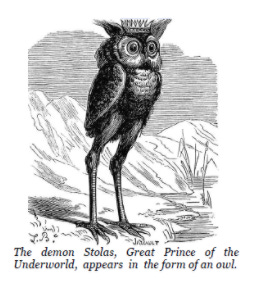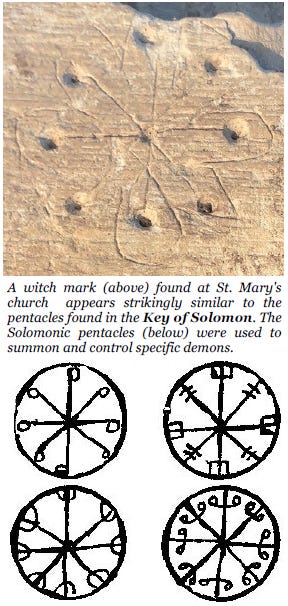Distracting Demons
Devils, demons and other minions of evil have been a fixture in cultures across the world for centuries. These diabolical entities manifest in various ways depending on the region and era. Asian countries contain legends of supernatural tricksters, known as Yōkai, that target earthly residents with misfortune or bad luck. In Middle Eastern folklore there are countless tales of the malicious Djinn - inhuman creatures that stalk the land and attach themselves to unwitting individuals, causing turmoil and strife. Religious themes factored heavily into the medieval European version of demonology - often involving Lucifer, the fallen angel from Heaven, leading a host of devilish creatures on a mission to tempt humanity and turn them away from Christian values. Constant vigilance was required to protect the innocent soul from falling victim to the fiendish plots and temptations that demons were thought to peddle. Luckily, according to some traditions, these fiendish monsters are easily distracted and effortlessly combated with the help of a few strategically-placed drawings.
Commonly known as “witch marks” or “demon traps” these simple images are most often found scratched into doorways, window frames, or chimneys of dwellings constructed during the middle ages (entrances and openings were believed to be susceptible to demonic intrusion). The symbols were intended to be a form of apotropaic magic, which includes charms, spells, and other talismans designed to deflect or entrap harmful presences. Variations of these marks have been found in places ranging from churches and castles to barns and caves; offering a glimpse into the superstitious way of life that was prevalent across the population.
Typical witch markings consisted of a sequence of interlocking lines and/or circles that ultimately formed a closed loop or unbroken pattern. Their creators believed that the symbols they drew acted as a maze-prison that could entice and ensnare a passing demon or spirit. Some archaic traditions hold that demonic entities are fascinated by elaborate designs, and if one of the creatures notices a line, they will follow its path until they find its end point. This bit of lore helps explain the reasoning behind some of the etchings that feature intricately carved overlapping shapes. It was believed that a wayward demon would be attracted by the configuration and subsequently captivate itself in a continuous search for the “end” of an unbroken line.
Witch marks recently made fresh headlines in the UK after a new trove was unearthed at the church of St. Mary’s, located in the village of Stoke Mandeville. The location was under excavation in the Fall of 2020 due to its proximity to England’s high speed railway construction project (known as HS2). St. Mary’s was originally established in 1070 and served as the local parish until it was condemned and destroyed in the mid-1800s. Archaeologists working at the dig site uncovered some striking examples of witching marks, including a wheel and spoke pattern chiseled into one of the building’s foundational blocks. The numerous “paths” contained within the circular wheel design provide the ideal labyrinth to occupy a wandering, line-tracing demon for eternity.
The geometrically influenced designs of certain demon traps were likely derived from symbols depicted in the famous occult grimoire, The Key of Solomon. Thought to have been compiled in Italy during the 1300s, The Key of Solomon, exists as one of the earliest and most complete examples of a step-by-step guide for conjuring and controlling spirits and demons. The magical manuscript is attributed to the legendary King Solomon, though it’s doubtful he was the original author. Portions of the spellbook contain images of seals and sigils that were believed to be imbued with specific powers (known as “pentacles,”these figures are commonly used in ritual magic). The ancient text provides detailed explanations for how a practitioner can harness and wield the latent energy associated with each pentacle, and many of the visual designs in the book bear strong resemblances to the witch marks found across the European continent.
Other witch marks were meant to behave less like a jail cell and more like an evil-repellant. In addition to swirling line and circle patterns, those seeking to ward off the devil and his ilk would often inscribe the letters VV (Virgin of Virgins) or AM (Hail Mary)in places around their property. These were shorthand references to the Virgin Mary and were installed specifically to invoke her protection. A striking and massive example of these marks was discovered in 2019 deep within the UK’s Creswell Crags cave system. With a history of occupancy that dates back to the Ice Age, the winding series of tunnels and caves is plastered with ancient “graffiti”. Thought to be the largest collection of its kind anywhere in the world, the dark interiors are littered with inscribed demon traps, witch marks, and protection sigils. The images are so pervasive, peppering every available stone surface in some instances, that they look like a scene from the movie A Beautiful Mind. Commenting on the almost obsessive nature of the numerous markings found in Creswell, an official with Historic England explained how “evil forces could readily be imagined in the dark. We can only speculate on what it was the people of Creswell feared might emerge from the underworld into these caves.” Whatever their impetus, it's abundantly clear that the locals feared what evil might reside in the depths and hoped their army of wards and traps scrawled into the ceilings and walls of the caves would stand guard against it.
Whether or not the symbols are effective protection against evil beings or instead act as a conduit through which demonic entities can be conjured forth (as outlined in the The Key of Solomon) requires further analysis of the specific sigils and their placement. What is clear from the multitude of marks recorded across the globe is that people have been quietly waging battle against malicious entities for centuries.







